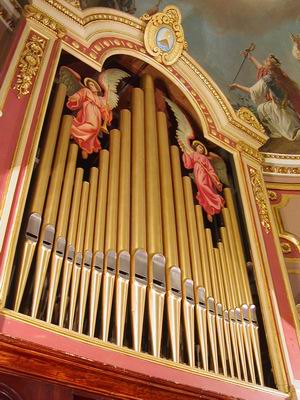 |
|
 |
| | Nadur Basilica Parish Church |  |
 |  |
| |
Cav. P. Inzoli 1897, 1914
 |  |  |  |  |  | | Facade and Case after restoration - angel paintings by Briffa |
|  |  |
View Photo Gallery
The famous organbuilder from Crema, Cav.Pacifico Inzoli, built a beautiful one-manual mechanical organ for Nadur Basilica in Malta’s sister island, Gozo. As with many organs in Malta and Gozo this organ was built in an extremely compact manner in order to fit as large an instrument as possible in the limited space available. Though this organ was quite complete as far as a one-manual can be, in 1914 Inzoli was asked to enlarge it by adding a real length (except the first 5 notes which are stopped) Principal 16’ and a 3-rank Viola chorus. The latter is a typical stop found on Italian organs built between 1900 and 1955. This enlargement, implemented by means of a pneumatic cone-chest, occupied completely all the limited access space available. To reach these pipes one must descend through a small window in the façade of the church.
This organ contains very interesting and unique features compared to other organs found in Malta. One of these is an Inzoli patented invention – somiere a doppio scompartimento – which is a special chest that allows certain pedal ranks to be independently available on the manual. Another feature is the pneumatic stop action which controls the combs of the mechanical spring chest and the double stop mechanism of the special pedal chest.
The restoration conducted by Robert Buhagiar in 2002 – 2003 consisted in the dismantling, restoration and re-assembly of most of the parts. Inzoli’s signiture was found on the inside of a pedal Bourdon cap. The most challenging aspect of the restoration was getting all the various pneumatic systems (especially the large pneumatic motors) to work reliably on the relatively low pressure of the pipework ie. 67mm in water column. The bellows together with the underlying pumps, spring windchest, stop action components, secondary bellows, flexibile trunking and mechanical action components were all transferred to the workshop and thoroughly restored in compiance with stringent restoration ethics. The tonal work consisted in cleaning and repair of the flue and reed pipes, followed by the usual small voicing corrections in full respect of the original voicing characteristics and tuning. One missing pipe was rebuilt. No tonal changes were carried out. On-site work included cleaning of the pallets of the special pedal chest and the inspection of the cone-valve chest which required only minimal work. The façade, consisting of zinc pipes was given back its original gold colour since it had been painted several times with grey paint.
Stoplist :
| Left Column | Right Column | Violone 8’ Soprani
Violone 8’ Basso*
Flauto Soprani
Flauto Bassi
Flutta Soprani
Voce Celeste (Soprani)
Oboe 8(Soprani)
Fagotto 8’ Bassi
Violoncello 16’ Soprani
Voci Umane 8 (Soprani)
Bordone 8’ (ped)**
Violone 8’ (ped)* | Principale 16’
Viola da Concerto 8’
Principale 8’ Bassi
Principale 8’ Soprani
Bordone 8’ Bassi**
Bordone 8’ Soprani
Ottava 4’ Bassi
Ottava 4’ Soprani
Decima V Bassi
Decima V Soprani
Dulciana Bassi
Ripieno 3 file
Basso di 8’ (ped)
Contrabasso 16’ (ped) |
Foot Levers
Tremolo
Unione tasto/pedale
Piano
MF
Ancie
Ripieno
Forte
Terza Mano (octave coupler from Middle C upwards)
Espressione (opens and closes a swell box for the Voci Umane reed stop)
Violini (inserts the 3 rank Viola da Concerto 8’)
Keyboard : 58 notes (C1-A58) splits between B24 and C25
Pedal : 24 notes (C1-B24)
|